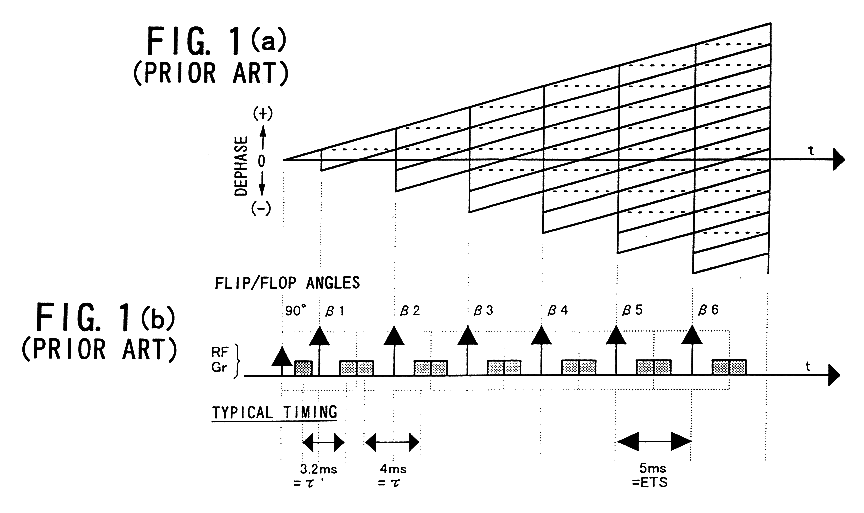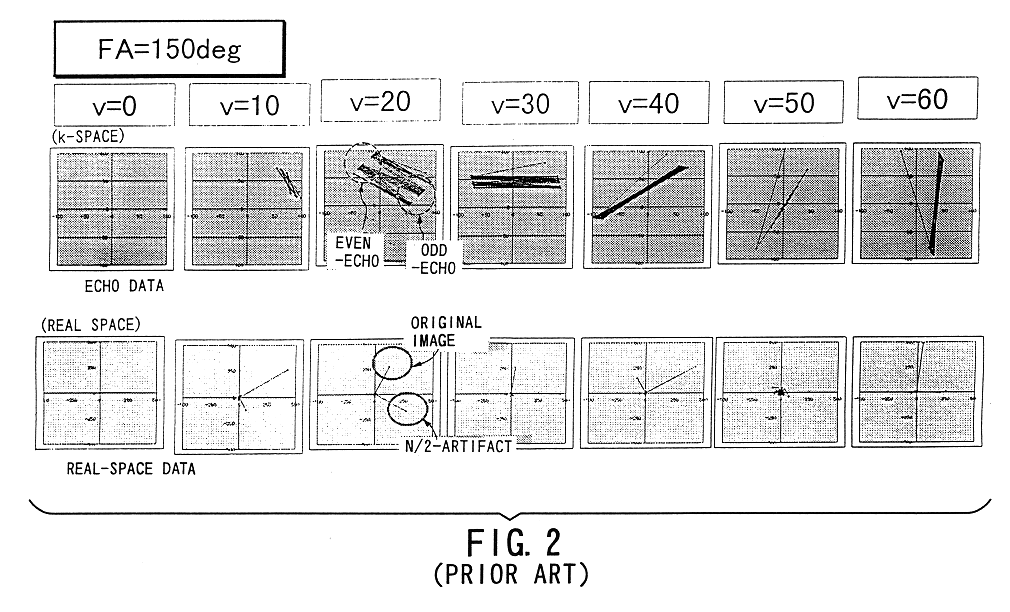Multi-echo sequence based MR imaging for fluid in motion
a multi-echo sequence and fluid in motion technology, applied in the field of medical magnetic resonance imaging, can solve the problems of prolonged interval between flip and flop pulse, insufficient for stable blood flow detection, and limited versatility
- Summary
- Abstract
- Description
- Claims
- Application Information
AI Technical Summary
Benefits of technology
Problems solved by technology
Method used
Image
Examples
first embodiment
An imaging technique according to the present invention will now be described with reference to FIGS. 8 to 10, which is practiced on the VIPS method through the foregoing MRI system. This embodiment is reduced to various modes as follows.
Mode 1:
A mode 1 practices the imaging technique on the VIPS method with a DIET (Dual Interval Echo Train) method. That is, to adjust an amount .o slashed.' of the initial phase shift for an initial echo, the DIET method is used.
The DIET method is known by Japanese Patent Laid-open Publication No. 7-155309 and a paper "H. Kanazawa et al., Contrast Neutralization of Fast Spin Echo Imaging: A Fat Reduction Technique Free from Field Inhomogeneity, 2.sup.nd SMR Scientific Program, p.486, 1994 / 8," of which one mode is that in a pulse sequence on the FSE method, an interval between the application of a 90-degree RF pulse and the acquisition of the first echo is set to odd times of three or more an interval between adjacent two echoes. A practical example i...
second embodiment
Referring to FIG. 11, a second embodiment of the present invention will now be described. This embodiment relates to imaging using a phase contrast method based on the FSE method.
In the FSE-system imaging, satisfying the ".o slashed. / 2" condition causes a phase shift proportional to the product between a gradient moment and a velocity obtained between echoes which sequentially follows the n-th echo. Precisely, as both the gradient moment and velocity take vector quantities of three dimensions, phase shifts to be generated are proportional to their scalar products. Assume that gradient moments are M0' and M0 (M0'=M0 / 2) for a fundamental sequence, where M0 takes three-dimensional vector quantities. This fundamental sequence is shown in FIG. 11(a), and this sequence is referenced by S0.
As a velocity encoding gradient, there is provided a sequence shown in FIG. 11(b), which called A1, where its initial phase MA1' and its repeated phases MA1 are determined so that the relationship of MA1...
third embodiment
A third embodiment of the present invention will be shown in FIG. 12. This embodiment involves blood flow imaging known as lower-flop type of black blood imaging.
Differently from the imaging methods according to the first and second embodiments, the imaging method in this embodiment provides a black blood imaging method that allows signals from blood flows to diminish almost completely.
As shown in FIG. 12, performing data acquisition through a pulse sequence based on an FSE method using a lower flop angle (for example, 90 degrees or less) remarkably decrease a depiction performance for blood flow signals. The third embodiment is derived from this fact, where in multi-echo imaging using refocusing RF pulses (flop pulses), their flop angles are assigned to a lower flop angle (for example, 90 degrees or less) that is unusable for the ordinary FSE imaging. A construction is such that information on this pulse sequence is sent to the sequencer 5 from the host computer 6. This makes it po...
PUM
 Login to View More
Login to View More Abstract
Description
Claims
Application Information
 Login to View More
Login to View More - R&D
- Intellectual Property
- Life Sciences
- Materials
- Tech Scout
- Unparalleled Data Quality
- Higher Quality Content
- 60% Fewer Hallucinations
Browse by: Latest US Patents, China's latest patents, Technical Efficacy Thesaurus, Application Domain, Technology Topic, Popular Technical Reports.
© 2025 PatSnap. All rights reserved.Legal|Privacy policy|Modern Slavery Act Transparency Statement|Sitemap|About US| Contact US: help@patsnap.com



